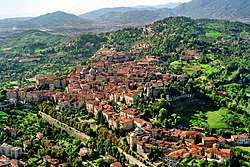Bergamo
| Bergamo | |||
|---|---|---|---|
| Comune | |||
|
The iconic skyline of the walled city of Bergamo | |||
| |||
| Nickname(s): Città dei Mille ("City of the Thousand") | |||
 Bergamo Location of Bergamo in Italy | |||
| Coordinates: 45°42′N 9°40′E / 45.700°N 9.667°ECoordinates: 45°42′N 9°40′E / 45.700°N 9.667°E | |||
| Country | Italy | ||
| Region | Lombardy | ||
| Province / Metropolitan city | Bergamo (BG) | ||
| Government | |||
| • Mayor | Giorgio Gori (PD) | ||
| Area | |||
| • Total | 38.7 km2 (14.9 sq mi) | ||
| Elevation | 249 m (817 ft) | ||
| Population (31 December 2015) | |||
| • Total | 119,381 | ||
| • Density | 3,100/km2 (8,000/sq mi) | ||
| Demonym(s) |
Bergamasque Bergamaschi (Italian) Bergamàsch (Eastern Lombard) | ||
| Time zone | CET (UTC+1) | ||
| • Summer (DST) | CEST (UTC+2) | ||
| Postal code | 24100 | ||
| Dialing code | (+39) 035 | ||
| Patron saint | Saint Alexander | ||
| Saint day | 26 August | ||
| Fortified City of Bergamo | |
|---|---|
|
Bergamo upper city and Bergamo hills. | |
| Type | Cultural |
| Criteria | iii, iv |
| Designated | 2017 (41 Session) |
| Part of | Venetian Works of Defence between 15th and 17th centuries: Stato da Terra – western Stato da Mar |
| Reference no. | 1533 |
| Region | Europe and North America |
Bergamo (Italian: [ˈbɛrɡamo] ![]() listen ; Lombard: Bèrghem,
listen ; Lombard: Bèrghem, ![]() listen ) is a city in Lombardy, northern Italy, about 40 km (25 mi) northeast of Milan, 30 km (19 mi) from the lakes Como and Iseo, 80 km from the lakes Garda and Maggiore. The foothills of the Bergamo Alps begin immediately north of the town. The historic core of the city (upper city) includes several monuments and museums, and the Venetian defensive systems are a UNESCO World Heritage Site since 9 July 2017.
listen ) is a city in Lombardy, northern Italy, about 40 km (25 mi) northeast of Milan, 30 km (19 mi) from the lakes Como and Iseo, 80 km from the lakes Garda and Maggiore. The foothills of the Bergamo Alps begin immediately north of the town. The historic core of the city (upper city) includes several monuments and museums, and the Venetian defensive systems are a UNESCO World Heritage Site since 9 July 2017.
Bergamo is the seat of the Province of Bergamo. With a population of around 120,000, Bergamo is the fourth-largest city in Lombardy. The metropolitan area of Bergamo extends beyond the administrative city limits, spanning over a densely urbanized area with slightly less than 500,000 inhabitants.[1]
The Bergamo metropolitan area is itself part of the broader Milan metropolitan area, home to over 8 million people.[2][3][4] As of 2015, Bergamo is the second most visited city in Lombardy after Milan.[5]
Bergamo is well connected to several cities in Europe and the Mediterranean through Il Caravaggio International Airport, the third-busiest airport in Italy with 10.5 million passengers in 2015, and the motorway A4 stretching on the axis between Milan, Verona, Venice, Turin and Trieste.
History
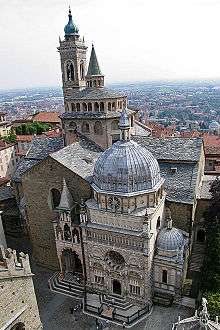
Antiquity
Bergamo occupies the site of the ancient town of Bergomum, founded as a settlement of the Celtic tribe of Cenomani. In 49 BC it became a Roman municipality, containing c. 10,000 inhabitants at its peak. An important hub on the military road between Friuli and Raetia, it was destroyed by Attila in the 5th century.
Middle Ages
From the 6th century Bergamo was the seat of one of the most important Lombard duchies of northern Italy, together with Brescia, Trento, and Cividale del Friuli: its first Lombard duke was Wallaris. After the conquest of the Lombard Kingdom by Charlemagne, it became the seat of a county under one Auteramus (d. 816). An important Lombardic hoard dating from the 6th to 7th centuries was found in the vicinity of the city in the 19th century and is now in the British Museum.[6]
From the 11th century onwards, Bergamo was an independent commune, taking part in the Lombard League which defeated Frederick I Barbarossa in 1165. The local Guelph and Ghibelline factions were the Colleoni and Suardi, respectively. Feuding between the two initially caused the family of Omodeo Tasso to flee north c. 1250, but he returned to Bergamo in the later 13th century to organize the city's couriers: this would eventually lead to the Imperial Thurn und Taxis dynasty generally credited with organizing the first modern postal service. From 1264, Bergamo was intermittently under the rule of Milan. In 1331, it gave itself to John of Bohemia, but the Milanese Visconti reconquered it.
Early modern
After a short period under the House of Malatesta starting from 1407, Bergamo was ceded in 1428 by the Duchy of Milan to the Republic of Venice in the context of the Wars in Lombardy and the aftermath of the 1427 Battle of Maclodio. Despite the brief interlude granted by the Treaty of Lodi in 1454, the uneasy balance of power among the Northern Italian states precipitated the Italian Wars, a series of conflicts from 1494 to 1559 that involved, at various times, also the Papal States, France, and the Holy Roman Empire.[7] The wars, which were both a result and cause of Venetian involvement in the power politics of mainland Italy, prompted Venice to assert its direct rule over its mainland domains. As much of the fighting during the Italian Wars took place during sieges, increasing levels of fortification were adopted, using such new developments as detached bastions that could withstand sustained artillery fire.[8]
The Venetian works of defence were built between 1561 and 1588, and Bergamo was transformed into a fortified city. It was meant to be a stronghold on the Western frontier with the Duchy of Milan, and to protect the trade routes leading into the Three Leagues territories (Grisons) and the Rhine Valley. While the countryside was seen as a cheap source of resources and workforce, the Venetian rule resulted in several urban improvements.
A Jacobin revolutionary municipality was established on 13 March 1797, in the context of the 1796 campaign led by the French Revolutionary Army, effectively ending more than three centuries of Venetian rule. The Treaty of Campo Formio (17 October 1797) formally recognized the inclusion of Bergamo and other parts of Northern Italy into the Cisalpine Republic, a "sister republic" of the French First Republic that was superseded in 1802 by the short-lived Napoleonic Italian Republic and in 1805 by the Napoleonic Kingdom of Italy.
Late modern and contemporary
At the 1815 Congress of Vienna, Bergamo was assigned to the Kingdom of Lombardy–Venetia, a crown land of the Austrian Empire. The visit of Ferdinand I in 1838 coincided with the opening of the new boulevard stretching into the plains, leading to the railway station that was inaugurated in 1857. The Austrian rule was at first welcomed, but later challenged by Italian independentist insurrections in 1848. Giuseppe Garibaldi conquered Bergamo in 1859, during the Second Italian War of Independence. As a result, the city was incorporated into the newly founded Kingdom of Italy. For its contribution to the Italian unification movement, Bergamo is also known as Città dei Mille ("City of the Thousand"), because a significant part of the rank-and-file supporting Giuseppe Garibaldi in his expedition against the Kingdom of the Two Sicilies came from Bergamo and its environs.
During the twentieth century, Bergamo became one of Italy's most industrialized areas. In 1907, Marcello Piacentini devised a new urban master plan that was implemented between 1912 and 1927, in a style reminiscent of Novecento Italiano and Modernist Rationalism. Bergamo was of the few Italian cities that did not suffer major destruction during World War II. Post-war years saw a prolonged period of strong economic growth well into the late 1960s, led by industrialization, large-scale manufacturing, and a vibrant environment of small and medium-sized enterprises.
Geography
Climate
Bergamo experiences a humid subtropical climate (Köppen climate classification Cfa) characteristic of Northern Italy. While most of Italy is characterized by dry summers with little to no precipitation, Bergamo has the reverse trend; the summer is wetter than winter. However, Bergamo's climate is designated with an f because there is statistically significant rainfall throughout the winter (in order to qualify for a w precipitation designation under the Köppen scale, the driest month in the winter would need to have less than 12.95 mm (1 in))
| Climate data for Bergamo (1971–2000, extremes 1946–present) | |||||||||||||
|---|---|---|---|---|---|---|---|---|---|---|---|---|---|
| Month | Jan | Feb | Mar | Apr | May | Jun | Jul | Aug | Sep | Oct | Nov | Dec | Year |
| Record high °C (°F) | 21.9 (71.4) |
22.7 (72.9) |
27.1 (80.8) |
31.9 (89.4) |
35.5 (95.9) |
36.3 (97.3) |
39.0 (102.2) |
37.9 (100.2) |
32.4 (90.3) |
29.0 (84.2) |
23.0 (73.4) |
19.0 (66.2) |
39.0 (102.2) |
| Average high °C (°F) | 6.6 (43.9) |
8.6 (47.5) |
13.0 (55.4) |
16.4 (61.5) |
21.4 (70.5) |
25.3 (77.5) |
28.3 (82.9) |
27.8 (82) |
23.4 (74.1) |
17.6 (63.7) |
11.1 (52) |
7.2 (45) |
17.2 (63) |
| Daily mean °C (°F) | 2.7 (36.9) |
4.4 (39.9) |
8.2 (46.8) |
11.4 (52.5) |
16.2 (61.2) |
19.9 (67.8) |
22.8 (73) |
22.6 (72.7) |
18.6 (65.5) |
13.3 (55.9) |
7.3 (45.1) |
3.4 (38.1) |
12.6 (54.7) |
| Average low °C (°F) | −1.1 (30) |
0.1 (32.2) |
3.3 (37.9) |
6.3 (43.3) |
11.0 (51.8) |
14.5 (58.1) |
17.3 (63.1) |
17.3 (63.1) |
13.8 (56.8) |
9.0 (48.2) |
3.4 (38.1) |
−0.3 (31.5) |
7.9 (46.2) |
| Record low °C (°F) | −15.0 (5) |
−20.1 (−4.2) |
−7.7 (18.1) |
−3.6 (25.5) |
1.7 (35.1) |
4.2 (39.6) |
8.9 (48) |
8.4 (47.1) |
5.1 (41.2) |
−1.7 (28.9) |
−7.0 (19.4) |
−12.4 (9.7) |
−20.1 (−4.2) |
| Average precipitation mm (inches) | 66.1 (2.602) |
54.0 (2.126) |
71.5 (2.815) |
87.4 (3.441) |
122.5 (4.823) |
121.2 (4.772) |
91.9 (3.618) |
100.3 (3.949) |
114.3 (4.5) |
121.5 (4.783) |
87.5 (3.445) |
64.4 (2.535) |
1,102.6 (43.409) |
| Average precipitation days (≥ 1.0 mm) | 7.1 | 5.3 | 7.0 | 9.3 | 11.1 | 9.1 | 6.3 | 7.2 | 6.5 | 8.3 | 7.1 | 6.6 | 90.9 |
| Average relative humidity (%) | 75 | 75 | 68 | 71 | 69 | 67 | 67 | 68 | 71 | 75 | 78 | 79 | 72 |
| Source: Servizio Meteorologico (humidity 1961–1990)[9][10][11] | |||||||||||||
Cityscape


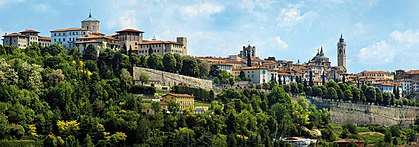
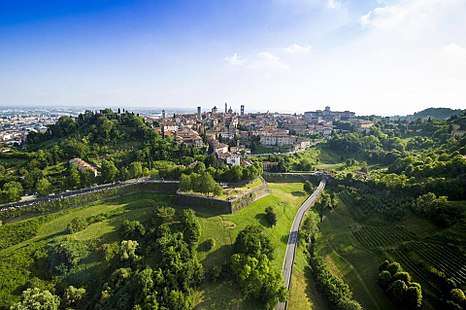
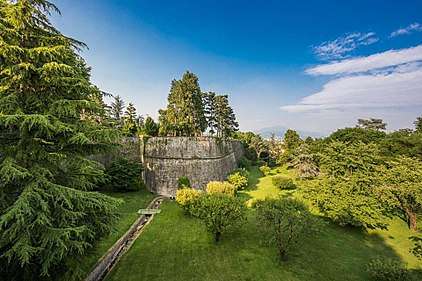
.jpg)
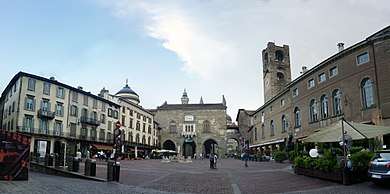
The town has two centres: Città alta ("upper city"), a hilltop medieval town, surrounded by 16th-century defensive walls, and the Città bassa ("lower city"). The two parts of the town are connected by funicular/cable car, roads, and footpaths.
Upper city

The upper city, surrounded by Venetian walls built in the 16th century, forms the historic centre of Bergamo.[12] Città Alta is an extremely expensive place to live in, with properties being sold for five to twelve thousand euro per square meter. This has numerous places of interest including:
- Cittadella (Citadel), built under the rule of the Visconti in the mid-14th century.
- Piazza Vecchia
- Palazzo della Ragione. This was the seat of the administration of the city in the medieval municipal period. Built in the 12th century, it was revamped in the late 16th century by Pietro Isabello. The façade has the Lion of Saint Mark ver a mullioned window, testifying to the long period of Venetian rule. The atrium has a well-preserved 18th-century sundial.
- Palazzo Nuovo (Biblioteca Civica Angelo Mai). It was designed by Vincenzo Scamozzi in the early 17th century and completed in 1928.
- Basilica di Santa Maria Maggiore. It was built from 1137 on the site of a previous religious edifice of the 7th century. Construction continued until the 15th century. Of this first building the external Romanesque structure and the Greek cross plan remain. The interior was extensively modified in the 16th and 17th centuries. The dome has frescoes by Giovanni Battista Tiepolo. Noteworthy are the great Crucifix and the tomb of Gaetano Donizetti.
- Cappella Colleoni, annexed to Santa Maria Maggiore, is a masterwork of Renaissance architecture and decorative art. It contains the tomb of Bartolomeo Colleoni.
- Battistero (Baptistry), an elegant octagonal building dating from 1340.
- Bergamo Cathedral. It was built in the late 17th century with later modifications.
- Rocca. It was begun in 1331 on the hill of Sant'Eufemia by William of Castelbarco, vicar of John of Bohemia, and later completed by Azzone Visconti. A wider citadel was added, but is now partly lost.
- San Michele al Pozzo Bianco. Built in the 12th century, this church contains several frescoes from the 12th to the 16th centuries, including paintings by Lorenzo Lotto.
- Museo Civico Archeologico. It is housed in the Cittadella.
- Museo di Scienze Naturali Enrico Caffi. It is housed in the Cittadella.
- Orto Botanico di Bergamo "Lorenzo Rota" (botanical garden).
Lower city
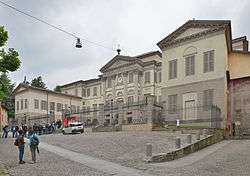
The lower city is the modern centre of Bergamo. At the end of the 19th century Città Bassa was composed of residential neighborhoods built along the main roads that linked Bergamo to the other cities of Lombardy. The main boroughs were Borgo Palazzo along the road to Brescia, Borgo San Leonardo along the road to Milan and Borgo Santa Caterina along the road to Serio Valley. The city rapidly expanded during the 20th century. In the first decades, the municipality erected major buildings like the new courthouse and various administrative offices in the lower part of Bergamo in order to create a new center of the city. After World War II many residential buildings were constructed in the lower part of the city which are now divided into several neighborhoods such as Longuelo, Colognola, Malpensata and Boccaleone, Redona and Valtesse among many others. The most relevant sites are:
- Accademia Carrara
- Galleria d'Arte Moderna e Contemporanea (Gallery of Modern and Contemporary Art), known as GAMeC.
Demographics
In 2010, there were 119,551 people residing in Bergamo (in which the greater area has about 500 000 inhabitants), located in the province of Bergamo, Lombardia, of whom 46.6% were male and 53.4% were female. Minors (children ages 18 and younger) totalled 16.79 percent of the population compared to pensioners who number 23.61 percent. This compares with the Italian average of 17.88 percent (minors) and 20.29 percent (pensioners). The average age of Bergamo residents is 45 compared to the Italian average of 43. In the eight years between 2002 and 2010, the population of Bergamo grew by 5.41 percent, while Italy as a whole grew by 5.77 percent.[13] The current birth rate of Bergamo is 8.4 births per 1,000 inhabitants compared to the Italian average of 9.3 births.
In 2010, 85% of the population was Italian. The largest immigrant group comes from other European nations (the largest being Romania and Ukraine): 4.89%, Americas (mostly from Cochabamba, Bolivia): 4.61%, sub-saharan Africa: 1.59%, and North Africa: 1.53%. Currently one-fifth of the babies born in Bergamo has at least one parent without Italian citizenship. The majority of the population is Roman Catholic, and the city hosts the see of a Catholic bishopric. There are also Orthodox Christian, Muslim, Protestant communities.
Economy
As capital and main town of its province, Bergamo hosts the public administration offices of provincial interest. In the past, many factories were in the commune territory, mainly for electrical components, industrial mechanics and publishing businesses, but have then moved outward. In the town three large corporations are based:
- UBI group, general headquarters of Italy's 4th largest banking group.
- Brembo, general headquarters and plants of the manufacturer of automotive brake systems' leader, especially for high-performance cars and motorcycles.
- Tenaris, is a global manufacturer and supplier of seamless and welded steel pipe products and provider of pipe handling, stocking and distribution services to the oil and gas, energy and mechanical industries.
- ABB SpA, offices and plants of a multinational corporation operating mainly in the power and automation technology areas.
Culture
Music
Bergamo has a prominent place in music history. The large Romanesque church of Santa Maria Maggiore, begun in 1137, had a continuous and well-documented tradition of music teaching and singing for more than eight hundred years. When the town was under Venetian control, the musical style of the Venetians was imported as well; in particular, a large instrumental ensemble grew up to support the choral singing. Composers such as Gasparo Alberti produced music with polyphony using two organs, brass and viols, a style usually associated with Venice, but which flourished in the fine acoustic environment of Santa Maria Maggiore.
The city lent its name to a style of folk dance known as bergamask peculiar to the peoples of that region. Known as bergomasci and renowned for their buffoonery, the fool Bottom in Shakespeare's A Midsummer's Night's Dream refers to their Bergomask dance. This unconventional form gave Debussy a vehicle for the dissonances and irregular intervals of his "Suite bergamasque".
Prominent musicians born in Bergamo include Gaetano Donizetti, Pietro Locatelli, Antonio Lolli, Gianluigi Trovesi, Roby Facchinetti, Alfredo Piatti, Fabrizio Frigeni and Gianandrea Gavazzeni. Alessandro Grandi, one of the most progressive composers of the early 17th century after Monteverdi, was maestro di cappella there until his death in the plague of 1630; Tarquinio Merula, an even more progressive composer, and one of the founders of the early sonata, took over his post.
Notable natives
Bergamo was the hometown and last resting place of Enrico Rastelli, a highly technical and world-famous juggler who lived in the town and, in 1931, died there at the early age of 34. There is a life-sized statue of Rastelli within his mausoleum. A number of painters were active in the town as well; among these were Giovanni Paolo Cavagna, Francesco Zucco, and Enea Salmeggia, each of whom painted works for the church of Santa Maria Maggiore. Sculptor Giacomo Manzù and the bass-baritone opera singer Alex Esposito[14] were born in Bergamo. The famous American electrical engineer and professor Andrew Viterbi, inventor of the important Viterbi's algorithm, was born in Bergamo, before migrating to the US during the Fascist era because of his Jewish origin. Designers born in Bergamo include the late Mariuccia Mandelli, the founder of Krizia and one of the first female fashion designers to create a successful line of men's wear.[15]
Sports
- Bergamo's football team is Atalanta who play in the top level Serie A at the Stadio Atleti Azzurri d'Italia.
- The town has a women's volleyball team named Foppapedretti Bergamo.
- The city is also home to the Bergamo Lions American football team, one of the most successful in European Football League history, winning multiple Eurobowls.
Education
Transportation

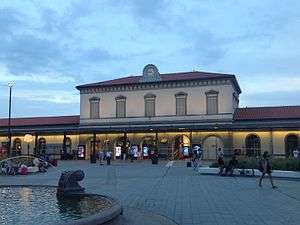
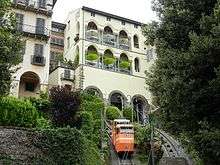
Airport
Bergamo is served by Il Caravaggio International Airport 5 km (3 mi) south-east of the town, the third busiest airport in Italy, serving 10.404.625 million passengers in 2015. The city is also served by Milan Linate Airport 50 km (31 mi) south-west of Bergamo.
Motorway
Motorway A4 is the main axis connecting the city with the east and the west of the country, to cities such as Milan, Turin, Venice and Trieste.
Railway
Bergamo railway station is connected to Milan, Lecco, Cremona, Treviglio, Brescia and Monza with regional trains operated by Trenord.
The city is also served by two daily Frecciargento services to Rome operated by Trenitalia.
Urban transport
Transport within Bergamo is managed by ATB and includes a network of bus lines together with two funicular systems opened in 1887 (Funicolare di Bergamo Alta) and in 1912 (Funicolare di Bergamo-San Vigilio). The Bergamo–Albino light rail was inaugurated in 2009.
Two light rail lines are currently in the planning stage:
- Line 2 Bergamo FS - Villa d'Almè - San Pellegrino Terme
- Line 3 Hospital-Railway Station FS-Trade Fair - Bergamo Airport
International relations
Twin towns − sister cities
Bergamo has a partnership with:
 Dąbrowa Górnicza, Poland[16]
Dąbrowa Górnicza, Poland[16] Bolesław, Poland[16]
Bolesław, Poland[16] Posadas, Argentina, as Friendship and Cooperation city since 1998[20]
Posadas, Argentina, as Friendship and Cooperation city since 1998[20]
Consulates
Bergamo is home to the following consulates:
See also
References
- ↑ "Urbanismi in Italia, 2011" (PDF). cityrailways.it (in Italian). Retrieved 4 November 2014.
- ↑ OECD Territorial Review - Milan, Italy
- ↑ "Archived copy" (PDF). Archived from the original (PDF) on 5 December 2008. Retrieved 22 March 2015. Competitiveness of Milan and its metropolitan area
- ↑ ISTAT
- ↑ "RSY Lombardia-Arrivals and nights spent by guests in accommodation establishments, by type of resort and by type of establishment. Total accommodation establishments. Part III. Tourist resort. Year 2012". asr-lombardia.it. Retrieved 4 November 2014.
- ↑ British Museum Collection
- ↑ Michael Mallett and Christine Shaw, The Italian Wars: 1494–1559. Harlow: Pearson Education Limited, 2012.
- ↑ Max Boot, War Made New: Technology, Warfare, and the Course of History, 1500 to Today. New York: Penguin Group, 2006.
- ↑ "Bergamo/Orio Al Serio (BG)" (PDF). Atlante climatico. Servizio Meteorologico. Retrieved March 6, 2015.
- ↑ "STAZIONE 076 Bergamo Orio Al Serio: medie mensili periodo 61 - 90". Servizio Meteorologico. Retrieved March 6, 2015.
- ↑ "Bergamo Orio al Serio: Record mensili dal 1946" (in Italian). Servizio Meteorologico dell’Aeronautica Militare. Retrieved March 6, 2015.
- ↑ "The city of Bergamo". UNESCO World Heritage Centre. Retrieved 1 February 2015.
- ↑ "Statistiche demografiche ISTAT". Demo.istat.it. Retrieved 15 April 2012.
- ↑ "Alex Esposito". www.roh.org.uk. Royal Opera House. Retrieved 25 February 2014.
- ↑ Fox, Margalit (2015-12-07). "Mariuccia Mandelli, Italian Fashion Designer, Dies at 90". New York Times. Retrieved 2016-01-04.
- 1 2 3 4 5 6 7 8 "Gemellaggi e relazioni internazionali" (official website) (in Italian). Comune di Bergamo. 7 April 2006. Retrieved 2015-03-28.
- ↑ "Pueblo's Sister Cities Home" (official website). Pueblo, CO, USA: Pueblo Sister Cities Commission. Retrieved 2015-03-28.
- ↑ "Convenios Internacionales" (official website) (in Spanish). Cochabamba, Bolivia: Gobierno Autónomo Municipal de Cochabamba. Archived from the original on 4 April 2015. Retrieved 28 March 2015.
- ↑ "Bergamo firma il gemellaggio con Olkusz" (in Italian). Comune di Bergamo. Retrieved 31 March 2015.
- ↑ "Posadas y sus hermanas" (in Spanish). Primera Edición. Archived from the original on 2 April 2015. Retrieved 28 March 2015.
- ↑ Consolato Onorario della BOLIVIA "Easydiplomacy Archived 1 January 2012 at the Wayback Machine.
- ↑ Consolato Onorario del Malawi a Bergamo > Company Profile | Guida Monaci
- ↑ Rappresentanze svizzere
Bibliography
External links
| Wikivoyage has a travel guide for Bergamo. |
| Wikimedia Commons has media related to Bergamo. |
- (in Italian) Municipality of Bergamo official website
- Visit Bergamo


